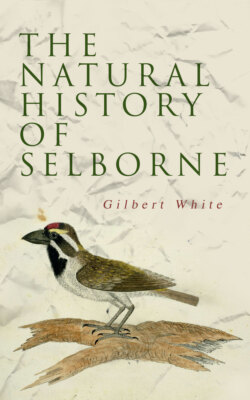Читать книгу The Natural History of Selborne - Gilbert White - Страница 11
На сайте Литреса книга снята с продажи.
LETTER VI.
ОглавлениеTable of Contents
Should I omit to describe with some exactness the forest of Wolmer, of which three-fifths perhaps lie in this parish, my account of Selborne would be very imperfect, as it is a district abounding with many curious productions, both animal and vegetable, and has often afforded me much entertainment both as a sportsman and as a naturalist.
The royal forest of Wolmer is a tract of land of about seven miles in length, by two and a half in breadth, running nearly from north to south, and is abutted on, to begin to the south, and so to proceed eastward, by the parishes of Greatham, Lysse, Rogate, and Trotton, in the county of Sussex; by Bramshot, Hadleigh, and Kingsley. This royalty consists entirely of sand covered with heath and fern, but is somewhat diversified with hills and dales, without having one standing tree in the whole extent. In the bottoms, where the waters stagnate, are many bogs, which formerly abounded with subterraneous trees, though Dr. Plot says positively, that “there never were any fallen trees hidden in the mosses of the southern counties.” But he was mistaken: for I myself have seen cottages on the verge of this wild district, whose timbers consisted of a black hard wood, looking like oak, which the owners assured me they procured from the bogs by probing the soil with spits, or some such instruments: but the peat is so much cut out, and the moors have been so well examined, that none has been found of late. Besides the oak, I have also been shown pieces of fossil wood of a paler colour, and softer nature, which the inhabitants called fir: but, upon a nice examination, and trial by fire, I could discover nothing resinous in them, and therefore rather suppose that they were parts of a willow or alder, or some such aquatic tree.
This lonely domain is a very agreeable haunt for many sorts of wild fowls, which not only frequent it in the winter, but breed there in the summer: such as lapwings, snipes, wild ducks, and, as I have discovered within these few years, teals. Partridges in vast plenty are bred in good seasons on the verge of this forest, into which they love to make excursions; and in particular, in the dry summers of 1740 and 1741, and some years after, they swarmed to such a degree that parties of unreasonable sportsmen killed twenty and sometimes thirty brace in a day.
But there was a nobler species of game in this forest, now extinct, which I have heard old people say abounded much before shooting flying became so common, and that was the heath-cock, black-game, or grouse. When I was a little boy I recollect one coming now and then to my father’s table. The last pack remembered was killed about thirty-five years ago; and within these ten years one solitary greyhen was sprung by some beagles in beating for a hare. The sportsmen cried out, “A hen pheasant!” but a gentleman present, who had often seen grouse in the north of England, assured me that it was a greyhen.
Nor does the loss of our black game prove the only gap in the Fauna Selborniensis; for another beautiful link in the chain of beings is wanting. I mean the red deer, which toward the beginning of this century amounted to about five hundred head, and made a stately appearance. There is an old keeper, now alive, named Adams, whose great grandfather (mentioned in a perambulation taken in 1635), grandfather, father, and self, enjoyed the head keepership of Wolmer Forest in succession for more than a hundred years. This person assures me, that his father has often told him that Queen Anne, as she was journeying on the Portsmouth road, did not think the forest of Wolmer beneath her royal regard. For she came out of the great road at Lippock, which is just by, and, reposing herself on a bank smoothed for that purpose, lying about half a mile to the east of Wolmer Pond, and still called Queen’s Bank, saw with great complacency and satisfaction the whole herd of red deer brought by the keepers along the vale before her, consisting then of about five hundred head. A sight this, worthy the attention of the greatest sovereign! But he farther adds that, by means of the Waltham blacks, or, to use his own expression, as soon as they began blacking, they were reduced to about fifty head, and so continued decreasing till the time of the late Duke of Cumberland. It is now more than thirty years ago that His Highness sent down a huntsman, and six yeoman-prickers, in scarlet jackets laced with gold, attended by the staghounds, ordering them to take every deer in this forest alive, and to convey them in carts to Windsor. In the course of the summer they caught every stag, some of which showed extraordinary diversion; but in the following winter, when the hinds were also carried off, such fine chases were exhibited as served the country people for matter of talk and wonder for years afterwards. I saw myself one of the yeoman-prickers single out a stag from the herd, and must confess that it was the most curious feat of activity I ever beheld, superior to anything in Mr. Astley’s riding-school. The exertions made by the horse and deer much exceeded all my expectations, though the former greatly excelled the latter in speed. When the devoted deer was separated from his companions, they gave him, by their watches, law, as they called it, for twenty minutes; when, sounding their horns, the stop-dogs were permitted to pursue, and a most gallant scene ensued.
